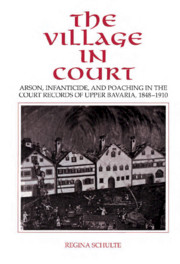 The Village in Court
The Village in Court Introduction: The breakup of the village
Published online by Cambridge University Press: 04 May 2010
Summary
THE PEASANT AS SEEN BY THE MIDDLE CLASS
Even before the peasants had been set free, released from the shackles of feudalism, their requiem had already begun. The peasant had, after all, become a citizen, “a full citizen in the economic sense.” In fact, the peasant's complete liberation had been conceived long before, with the enthusiasm for progress that accompanied the emancipation of the serfs. Thus, in the first half of the nineteenth century, a new figure saw the light of day – the “farmer,” released from the traditionalism of the peasant and oriented toward the future. “Rational” in his approach to farming, he now ran a “business,” just like a craftsman or mill owner. He kept pace with progress, which was now set to overtake the countryside, too.
Agriculture is a business, the purpose of which is to yield a profit, or earn money, by producing (and occasionally processing) vegetable and animal substances. The larger the profit, on a regular basis, the more completely this purpose is achieved. The perfect kind of agriculture is thus that which extracts the highest and most sustained profit possible from the business in proportion to capital, manpower, and other circumstances.
But those who announced the birth of the “farmer” were not the peasants themselves but enlightened civil servants, clergymen, and country noblemen, members of learned agricultural societies and academies, who were now applying the emerging civil society's ideas of economics and labor to the country. Civil society was reflected, as it were, in its “picture of the peasant.” In this pitiable creature that for centuries had been despised, the city dweller now discovered the backwoodsman in a wilderness devoid of civilization.
- Type
- Chapter
- Information
- The Village in CourtArson, Infanticide, and Poaching in the Court Records of Upper Bavaria 1848–1910, pp. 1 - 22Publisher: Cambridge University PressPrint publication year: 1994
